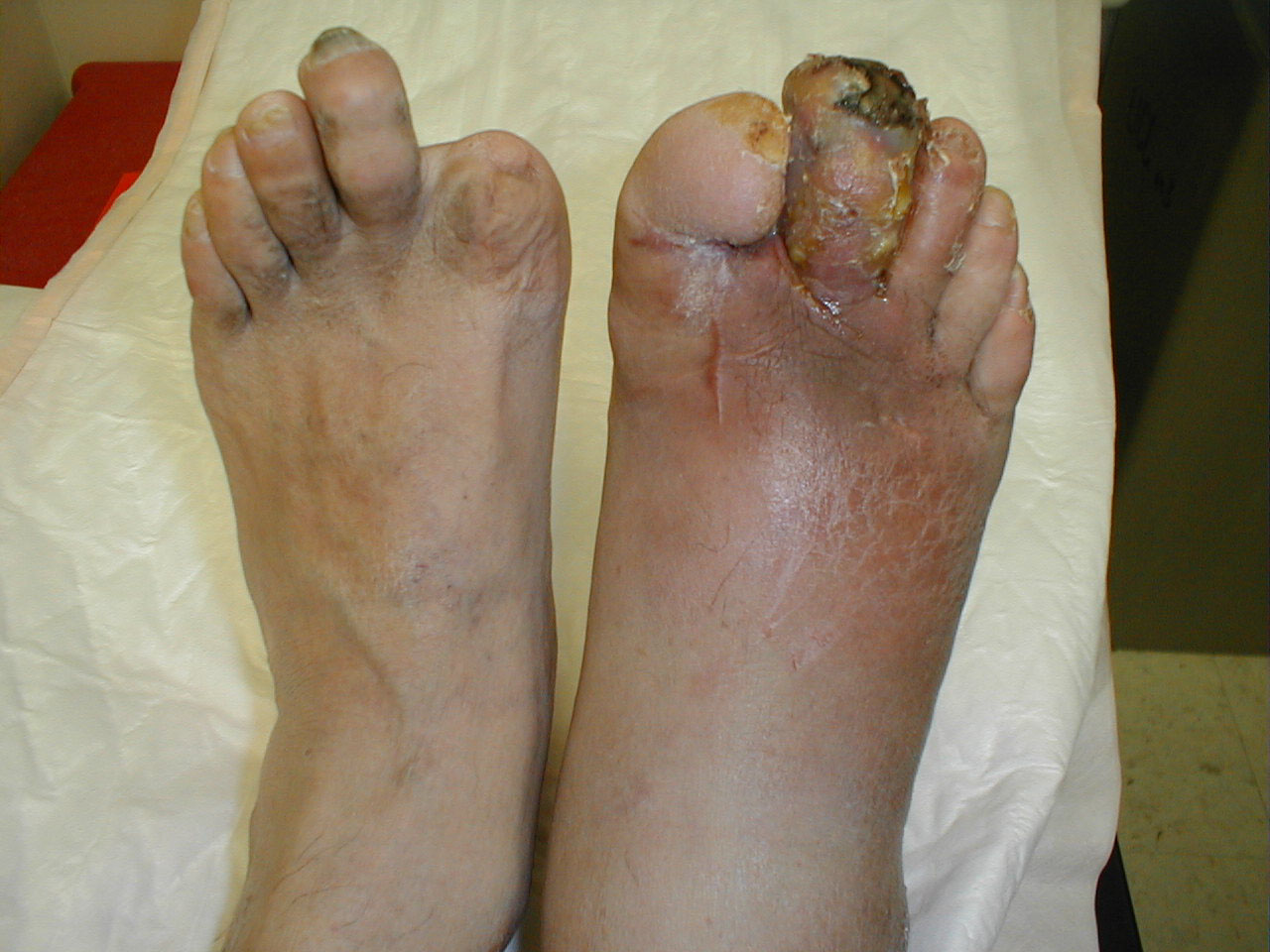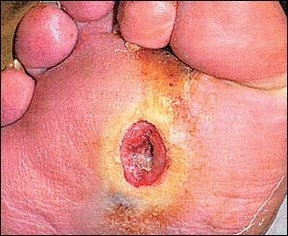Diabetic foot
For patient information, click here
| Diabetic foot | |
 | |
|---|---|
| Diabetic Foot Infection: Cellulitis and gangrene. (Image courtesy of Charlie Goldberg, M.D., UCSD School of Medicine and VA Medical Center, San Diego, CA) |
|
Diabetic foot Microchapters |
|
Diagnosis |
|---|
|
Treatment |
|
Case Studies |
|
Diabetic foot On the Web |
|
American Roentgen Ray Society Images of Diabetic foot |
|
Diabetes mellitus Main page |
|
Patient Information |
|---|
Editor-In-Chief: C. Michael Gibson, M.S., M.D. [1]; Afsaneh Morteza, MD-MPH [2] Associate Editor(s)-In-Chief: Priyamvada Singh, M.B.B.S. [3]; Cafer Zorkun, M.D., Ph.D. [4]
Complications
Patients with diabetic foot have an increased risk of all-cause mortality, especially cardiovascular disorders, compared with patients with diabetes without a history of diabetic foot ulcer.[1]
Diagnosis and Evaluation
A complete physical examination and patient history is the first step. it include dermatologic, vascular, neurologic and bone examination.
Dermatologic Examination
- Visual inspection of the skin: peeling skin, maceration, fissuring between toes
- Skin temperature: Should be warm at the tibia cold at distal toe .
- Look for deformities, charcot foot, hammer toe, and heels.
Vascular Assessment
Pulses: Bilaterally, dorsalis pedis, posterior tibialis, popliteal and superficial femoral. ABI measurement:
- Normal 1-1.3
- Non compressible calcified >1.3
- Stenosis <0.9
- Advanced ischemia <0.4
Arterial oxygen supply could also be measured by transcutaneous oxymetery
Neuropathy Assessment
Symptoms including burning, pin, needles, at early stages
Using neuropathy symptoms score (NSS)[2] and neuropathy disability score (NDS),[3]. Almost half of the patients with diabetes have some level of neuropathy prior to diagnosis. the physician should assess;
- Muscle strength and tone
- Temperature
- Sensation
- Light touch
- Filament nerve conduction studies
- Quantitative sensory testing and autonomic testing.
Diabetic Foot Physical Examination
Inspection
- Dilated veins
- Scar, Sinuses
- Shiny skin
- Hair distribution
- Areas of Pigmentation
- Areas of discolouration
- Varicose vein
- Ulcers
- Brittle or broken nail
- Fungal infection
Palpation
- Temperature (increase temperature- deep vein thrombosis, decrease temperature-ischemia)
- Tenderness (squeeze calf muscle and achilles tendon for tenderness)
- Pulsation- Dorsalis pedis
- Capillary filling time
- Ulcers in pressure areas like ball of great toe, base of fifth metatarsal, posterior aspect of heel
Motor Examination
- Nutrition/Bulk
- Tone
- Power
- Reflexes
Sensory
- Vibration
- Joint position sense
Video: Physical Examination Diabetes
{{#ev:youtube|715j6zRZHaA}}
Video: Diabetic Foot Care
{{#ev:youtube|DASvmFJeYX8}}
Image: Diabetic Foot Ulcer

Treatment
Foot ulcers in diabetes require multidisciplinary assessment, usually by diabetes specialists and surgeons. Treatment consists of appropriate bandages, antibiotics (against staphylococcus, streptococcus and anaerobe strains), debridement and arterial revascularisation. It is often 500 mg to 1000 mg of flucloxacillin, 1 g of amoxicillin and also metronidazole to tackle the putrid smelling bacteria. Specialists are investigating the role of nitric oxide in diabetic wound healing. Nitric oxide is a powerful vasodilator, which helps to bring nutrients to the oxygen deficient wound beds. Specialists are using forms of light therapy such as LLLT to treat diabetic ulcers.
Prevention
Foot ulcers can be prevented by is by frequent physical examinations, good foot hygiene, diabetic socks and shoes, and by avoiding injury.
- Foot-care education combined with increased surveillance can reduce the incidence of serious foot lesions [4].
- Footwear; all major reviews recommend special footwear for patients with a prior ulcer or with foot deformities. One review added neuropathy as an indication for special footwear. The comparison of custom shoes versus well-chosen and well-fitted athletic shoes is not clear.
Clinical Trials
Clinical Evidence reviewed the topic and concluded "Individuals with significant foot deformities should be considered for referral and assessment for customized shoes that can accommodate the altered foot anatomy. In the absence of significant deformities, high quality well fitting non-prescription footwear seems to be a reasonable option" [5].
National Institute for Health and Clinical Excellence has reviewed the topic and concluded that for patients at "high risk of foot ulcers (neuropathy or absent pulses plus deformity or skin changes or previous ulcer" that "specialist footwear and insoles" should be provided [6]
A meta-analysis by the Cochrane Collaboration concluded that "there is very limited evidence of the effectiveness of therapeutic shoes" [7]. However, the meta-analysis was published before the major trial that is in the table below.
The major randomized controlled trial of specialized footwear show no benefit in patients with a prior foot ulceration (see table below).[8] A prior, smaller, non-randomized trial that showed benefit of custom foot wear in patients with a prior foot ulceration.[9]. In this trial, the number needed to treat was 4 patients.
| Trial | Patients | Intervention | Comparison | Outcome | Results | Comment | |
|---|---|---|---|---|---|---|---|
| Intervention | Control | ||||||
| Litzelman[4] 1993 |
395 patients • general medicine practice |
Patient and provider education | Usual care | • Any foot lesion • Serious foot lesions at one year |
Not reported | • 11% • 2.9% |
• Insignificant • Significant reduction |
| Lincoln[11] 2008 |
172 patients • Prior ulceration • specialist clinic |
Targeted, one-to-one education | Usual care | Re-ulceration at • 1 year 2 years |
• 30% • 41% |
• 20% • 41% |
• Insignificant • Insignificant |
| McCabe[10] 1998 |
2002 patients • high-risk • general diabetic clinic |
Screening and referral to foot-care clinic if they had prior ulcer, had low ankle–brachial index (<0.75), or had foot deformities | Usual care | • Ulceration within 2 years • Amputation rates |
• 2% • 0.1% |
4% 1.2% |
• Insignificant • Significant |
| Reiber[8] 2002 |
400 patients • Prior ulceration • Excluded severe deformity |
Therapeutic shoes | Usual footwear | Re-ulceration | 15% | 17% | Insignificant difference |
External Links
- Diabetic Foot Research Page at the Center for Lower Extremity Ambulatory Research; for Professionals and Patients
- Imaging of the Diabetic Foot and Its Complications
- Assessing The Potential of Nitric Oxide in the Diabetic Foot
- Maggot Therapy Project
References
- ↑ Brownrigg JR, Davey J, Holt PJ, Davis WA, Thompson MM, Ray KK; et al. (2012). "The association of ulceration of the foot with cardiovascular and all-cause mortality in patients with diabetes: a meta-analysis". Diabetologia. 55 (11): 2906–12. doi:10.1007/s00125-012-2673-3. PMID 22890823.
- ↑ Meijer JW, Smit AJ, Sonderen EV, Groothoff JW, Eisma WH, Links TP (2002). "Symptom scoring systems to diagnose distal polyneuropathy in diabetes: the Diabetic Neuropathy Symptom score". Diabet Med. 19 (11): 962–5. PMID 12421436.
- ↑ Daousi C, MacFarlane IA, Woodward A, Nurmikko TJ, Bundred PE, Benbow SJ (2004). "Chronic painful peripheral neuropathy in an urban community: a controlled comparison of people with and without diabetes". Diabet Med. 21 (9): 976–82. doi:10.1111/j.1464-5491.2004.01271.x. PMID 15317601.
- ↑ 4.0 4.1 4.2 Litzelman D, Slemenda C, Langefeld C, Hays L, Welch M, Bild D, Ford E, Vinicor F (1993). "Reduction of lower extremity clinical abnormalities in patients with non-insulin-dependent diabetes mellitus. A randomized, controlled trial". Ann Intern Med. 119 (1): 36–41. PMID 8498761.
- ↑ Hunt D. "Foot ulcers and amputations in diabetes". Clin Evid: 455–62. PMID 16620415. Text " based on September 2005 search" ignored (help)
- ↑ "Scope: Management of type 2 diabetes: prevention and management of foot problems (update)" (PDF). Clinical Guidelines and Evidence Review for Type 2 Diabetes: Prevention and Management of Foot Problems. National Institute for Health and Clinical Excellence. 20 February 2003. Retrieved 2007-12-04.
- ↑ Spencer S. "Pressure relieving interventions for preventing and treating diabetic foot ulcers". Cochrane Database Syst Rev: CD002302. doi:10.1002/14651858.CD002302. PMID 10908550.
- ↑ 8.0 8.1 8.2 Reiber GE, Smith DG, Wallace C, Sullivan K, Hayes S, Vath C; et al. (2002). "Effect of therapeutic footwear on foot reulceration in patients with diabetes: a randomized controlled trial". JAMA. 287 (19): 2552–8. PMID 12020336.
- ↑ Uccioli L, Faglia E, Monticone G, Favales F, Durola L, Aldeghi A, Quarantiello A, Calia P, Menzinger G (1995). "Manufactured shoes in the prevention of diabetic foot ulcers". Diabetes Care. 18 (10): 1376–8. PMID 8721941.
- ↑ 10.0 10.1 McCabe CJ, Stevenson RC, Dolan AM (1998). "Evaluation of a diabetic foot screening and protection programme". Diabet Med. 15 (1): 80–4. doi:10.1002/(SICI)1096-9136(199801)15:1<80::AID-DIA517>3.0.CO;2-K. PMID 9472868.
- ↑ 11.0 11.1 Lincoln NB, Radford KA, Game FL, Jeffcoate WJ (2008). "Education for secondary prevention of foot ulcers in people with diabetes: a randomised controlled trial". Diabetologia. 51 (11): 1954–61. doi:10.1007/s00125-008-1110-0. PMID 18758747.
- Pages with reference errors
- CS1 maint: Explicit use of et al.
- CS1 maint: Multiple names: authors list
- Pages with citations using unnamed parameters
- Disease
- Medicine
- Emergency medicine
- Endocrinology
- Mature chapter
- Diabetes
- Aging-associated diseases
- Medical conditions related to obesity
- Primary care
- Intensive care medicine